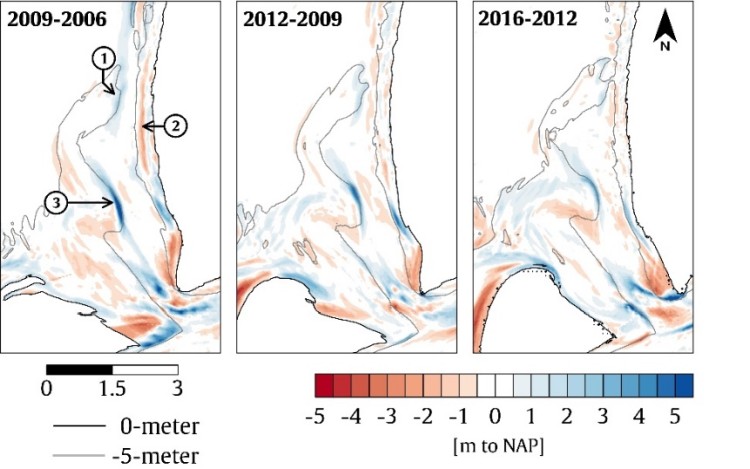F. Galiforni-Silva1*, K.M. Wijnberg1, S. J. M. H. Hulscher1
1 University of Twente,
Introduction
In tidal inlets, one of the leading sand input processes to a coastline stretch happens in the form of shoal attachment (Gaudiano and Kana, 2001). The process is characterized by an accumulation of sand that detaches from the ebb-tidal delta and moves towards the coastline, leading to several changes in the neighbouring beach-dune system. Recent insights from Texel (NL) show that a vast ebb-tidal shoal is attaching the coast (Elias and van der Spek, 2017). Such attachment will lead to currently unknown changes in the adjacent beach-dune system. The objective of this study is to evaluate potential scenarios of beach-dune development due to shoal attachment.
Methods
We used a combination of bathymetric (since 1991) and LiDAR (since 1997) datasets available for the area to understand the past behaviour of both the beach-dune system and the shoal. We tracked shoal displacement through both elevation and volume changes. For the beach-dune system, we tracked shoreline variability, dunefoot and dune volume evolution based on 47 cross-shore profiles along the southwest coast of Texel extracted from the LiDAR data.
Results and Discussion
Results show two sand shoals with distinct behaviour and potential consequence for the coastline (Figure 1). The northern tip (1) moves landward and pushes the channel towards the coast, leading to increased erosion of the beach (2). The second one (3) presents higher elevation changes and moves northeast. For (3), the channel is not forcing any coastline erosion. Channel migration and nourishments control shoreline movement and dunefoot. Dune volume presents an accretive trend, with higher accretion in the southern zone and sparse erosive years in the erosion hotspot. Based on data insights and previous studies, we hypothesize that the attachment of the shoal will lead to an increase in beach width and a consequent seaward movement of the dunefoot, but not necessarily an increase in accretion rates of dune volume (Galiforni-Silva et. al., 2019). Considering a channel-induced erosion, monitoring the next shoal cycle will potentially give us the buffering capacity of a shoal-induced shoreline and the necessity of any adjustment in current management practices.

Figure 1 Bathymetric difference maps highlighting three main erosion/accretion characteristics. Isobaths based on 2009, 2012 and 2016 surveys, respectively.
References
Elias, E. P. L., & van der Spek, A. J. F. (2017). Dynamic preservation of Texel Inlet, the Netherlands: understanding the interaction of an ebb-tidal delta with its adjacent coast. Netherlands Journal of Geosciences, 96(4), 293–317. https://doi.org/10.1017/njg.2017.34
Galiforni-Silva, F., Wijnberg, K. M., de Groot, A. V., & Hulscher, S. J. M. H. (2019). The effects of beach width variability on coastal dune development at decadal scales. Geomorphology, 329, 58-69. https://doi.org/10.1016/j.geomorph.2018.12.012
Gaudiano, D.J.; Kana, T.W. (2001). Shoal Bypassing in Mixed Energy Inlets: Geomorphic Variables and Empirical Predictions for Nine South Carolina Inlets. Journal of Coastal Research, 17, 280–291.
I. Surname1*, F.N. Another-Surname2 , Y. Next-Surname2
1 University Name, Country; 2 Organization Name, Country
* Corresponding author: mail.name@organization.org


